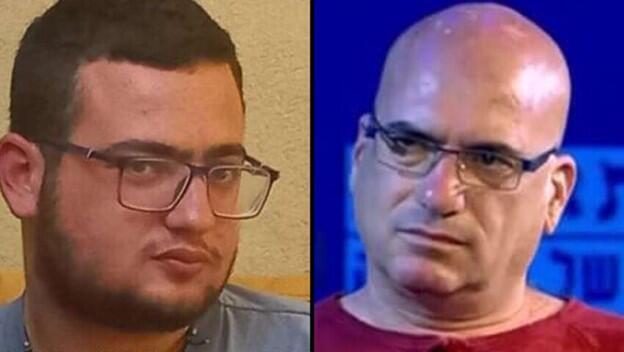Getting your Trinity Audio player ready...
On the evening of October 6th, Neta Portal was in the small apartment that she rented in Kibbutz Kfar Aza with her partner Santiago Perez. It was a normal, sleepy October weekend, with nothing too exciting planned. Later in the evening, Portal’s good friend came over to visit on her way to the Nova Music Festival nearby. “We thought about going too, but in the end decided not to," Portal recalls. "We stayed home and went to sleep really, really late."
Read more:
At 6:30 am, the couple was woken by the sound of warning sirens, like everybody else. "My boyfriend Santi ran to the door to try to see the rockets being intercepted by the Iron Dome. I told him to get into the safe room and we remained there, locked in."
9 View gallery
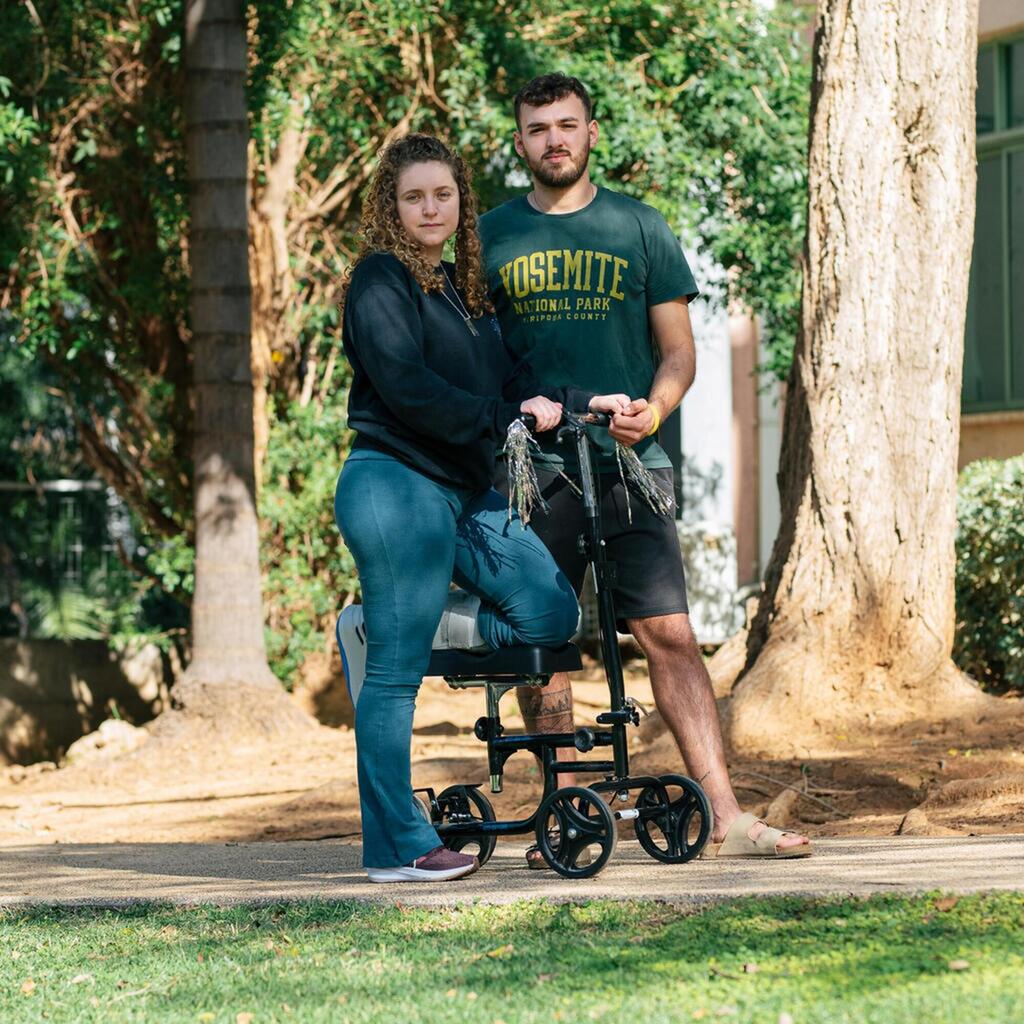

They met while traveling in South America after the army and decided to live together in Kfar Aza; Neta Portal and Santiago Perez
(Photo: Raphael Shachari)
"At around 7:00 am, we received a message through the kibbutz WhatsApp group that terrorists may have infiltrated. Until then, we heard lots of explosions and understood that something was wrong, but at that moment we realized that a much bigger event was happening," she recounts.
The explosions became more intense. At around 8:00 in the morning, Santiago texted a friend on the kibbutz, the late Nitzan Libstein, whose father, Ofir Libstein, was then the head of the Sha’ar HaNegev Regional Council. "He asked Nitzan what was going on, if he knew what was happening outside. Nitzan calmed him down and told him not to worry, that army units are on the way," Portal recalls.
"We remained locked in the safe room, and I was mainly worried about my friend at the Nova Festival. I spoke to her on the phone at around 7:30. I told her to come to us in Kfar Aza, that we have a safe room, and everything is fine. She answered me while running that she can’t talk, and that’s when I lost contact with her," she said.
During this time, Portal and Perez started to hear screaming outside. "The apartment next to ours was hit by a rocket. We started to be really quiet and nervous. I wrote to my family. I told my mother that I could hear gunshots and she told me that it probably means that the army is fighting, that I shouldn’t worry and that I should be strong."
"At this stage, we didn’t answer the phone. Santi sent another text to Nitzan. He replied that his father and grandmother had just been murdered and that we shouldn’t leave our house because it was dangerous. That’s when the penny dropped, and we understood that there are terrorists inside the kibbutz," Portal said.
"Santi got up from the bed and held the safe room’s door handle. I wanted someone to know that we were in trouble. I wrote in my friends’ WhatsApp group that they should call the police, that the terrorists were here. I understood that terrorists were close by, but I didn’t realize that they were entering every house and killing people. One of my friends wrote to me that the police weren’t answering and that their call center was unable to receive calls. That was at around 10:30 am," she said.
"She asked me to write to my Dad, who is a police officer (Deputy Chief Superintendent Shimon Portal). I texted him that I was in Kfar Aza and that there are terrorists and that I need help. He answered that there was a tactical unit on the way and that he’s coming," she added
Two minutes later, the electricity went off. "We had no way of communicating," Portal remembers. "We sat, tense, in the safe room in silence and in the dark. We could hear them yelling near the window of our apartment. Santi told me that they were going to break the window. Ten minutes later, that’s what happened."
"They entered our apartment screaming; they approached the safe room and tried to open the door. Santi didn’t let them turn the door handle. A second later, someone shot a round of bullets at the door. Santi was hit in his right leg by two bullets and was also wounded by a bullet that brushed his head, and he started to bleed. I was hit in my right leg by a bullet that went through the door. The bullet was stuck in my knee. At that point, we were in shock; we couldn’t believe that we had been shot. Who knew that bullets could go through the safe room door?”
9 View gallery
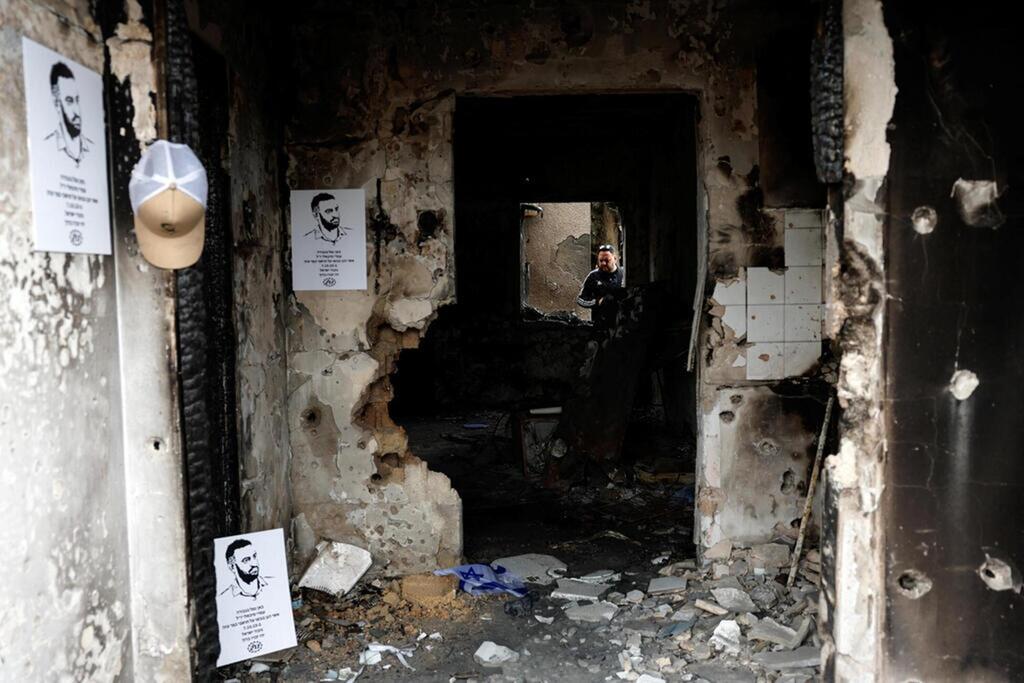

Kibbutz Kfar Aza: remains of the house where Sgt. Maj. (Res.) Omri Michaeli was killed
(Photo: Reuters / Amir Cohen)
Neta continues: "I tried to text my father again even though there was no phone reception or electricity. I wrote ‘Dad, I was shot. Help,’ and I sent the location of our apartment. Santi signaled to me with his eyes and whispered to me to open the window. I saw around 15 terrorists in the parking lot, leaning on vehicles, smoking cigarettes and laughing."
"Some were wearing the Hamas’s green ribbons, some wore IDF uniforms. I couldn’t believe it. I froze. Luckily, there was a small tree that blocked the view of our window. I saw that the border fence was completely breached, and the entire back gate was broken," she added.
"That very second, Santi – who was still holding the safe room’s door handle so that the terrorists wouldn’t be able to get in – heard something metallic thrown at the door, probably a grenade. He let go of the door handle, threw me out the window and jumped out. He didn’t know that there were terrorists outside. We started to run deep into the kibbutz, in the opposite direction of the fence."
The terrorists saw the couple escaping from the apartment but chose not to chase after them. "They simply stood in a row and shot enormous amounts of ammunition at us with automatic weapons," says Portal. "Six more bullets hit me, three in the left ankle, two in the left thigh and one in my arm. I fell on my face. Santi was several meters ahead of me, but when he saw that I wasn’t next to him, he turned back to pick me up," she recalls.
"During that time, he was hit in the back by another bullet and yelled at me: ‘Neta, if you don’t run, we will die.’ Everything happened within seconds. We managed to run two blocks and reached the entrance to a house. Santi tried to open the doors to the apartments but he couldn’t. We didn’t want to make any noise – at this stage, we didn’t know if they were running after us or not,” she added.
9 View gallery
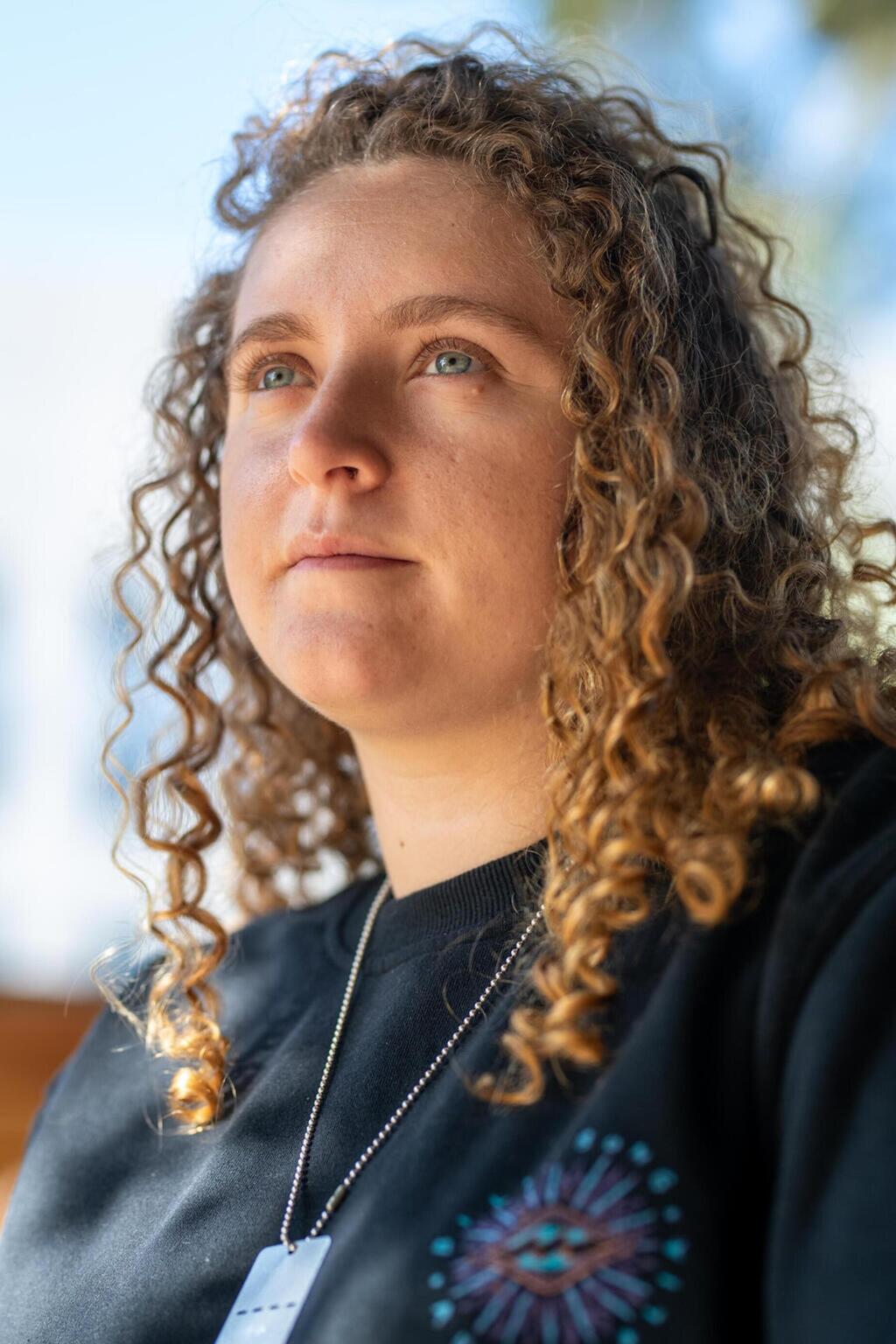

Neta’s father, who is a police officer, came to rescue his daughter. Neta Portal, a survivor of the massacre at Kfar Aza
(Photo: Raphael Shachari)
They found temporary shelter between two apartments. “Santi took off his undershirt and made me a tourniquet for my left leg, which had been hit by five bullets and had an open fracture in the ankle. The house was slightly elevated and had a crawl space under it where we could fit. He took out all the garbage that was there and we went in and hid there for three and a half hours."
Eventually, after a nerve-wracking wait, they heard the voices of two people who were running and out of breath. "Santi saw that they were in uniform and after a few sentences, he understood that they were soldiers. He went out and yelled at them. It turned out that they were a few guys from the Border Police unit that had entered the kibbutz on their own."
"They had come in on foot and didn’t have a way to rescue us. At this point, I broke down. For hours I had been fighting not to lose consciousness, I had seven bullet wounds, I really needed them to get me out of there," Portal said. "I didn’t care about anything, not about the terrorists or anything else. I begged them not to leave us there. I screamed ‘please don’t leave me here!’"
“At that moment, I thought about my father. I yelled his phone number at them and they called him. While we had been hiding, he had been trying to get inside the kibbutz. He actually went in with three other police officers, each one from a different unit, in an armored police vehicle. Together with a few other soldiers, they managed to save a family. They went into the kibbutz and took us out to Sderot. From Sderot, we were evacuated to Barzilai Hospital, and from there I went to Meir Hospital, where they operated on me. Since then, I've been at the Loewenstein Rehabilitation Center."
9 View gallery
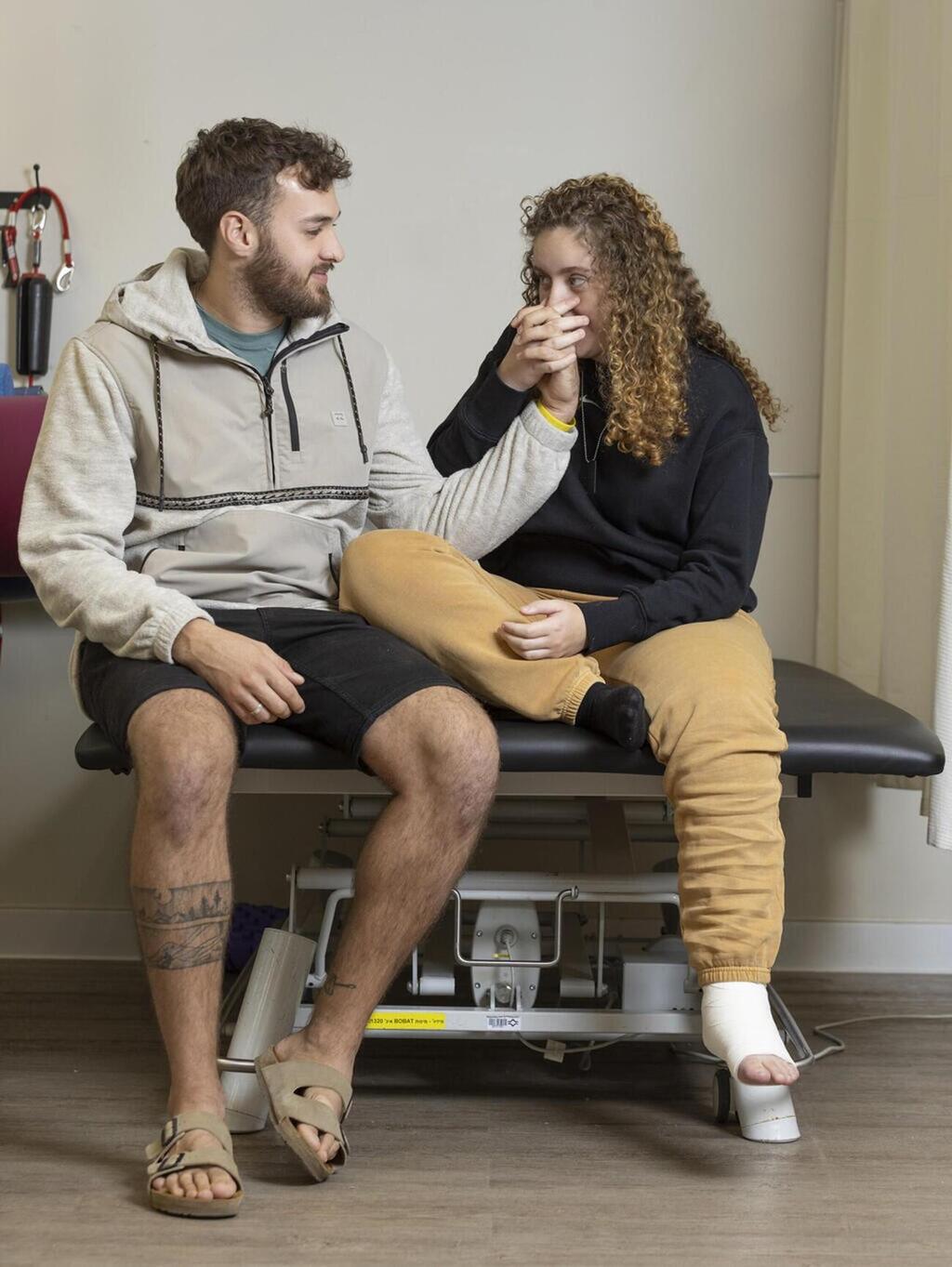

Neta Portal and her partner Santiago Perez from Kfar Aza at the Loewenstein Rehabilitation Center
(Photo: Avigail Uzi)
Learning to walk again
As a result of her serious injuries, Portal faced a complicated recovery period. "I came to the Loewenstein Center with both legs not functioning at all. My right arm also wasn’t functioning because a bullet had hit the tendons that straighten the arm. My main injury was to my left ankle," she explains. "The ankle was completely shattered; it couldn’t hold my body weight. However, for the bone to heal and for the leg to be able to move, we looked for a way for me to step on it without it carrying my weight."
Dr. Amir Haim, director of the Biomechanical Rehabilitation Unit at the Loewenstein Rehabilitation Medical Center, explains the complicated treatment. "Neta suffered from a wound to the ankle bone, which is very complicated to treat. Due to her condition, we couldn’t let her step on the foot. Doing so could damage the entire movement chain of her skeleton and body. The whole body would be affected. As an orthopedic and rehabilitation specialist, it was very important for me to recreate her walking and movement functions so as to avoid further damage."
9 View gallery
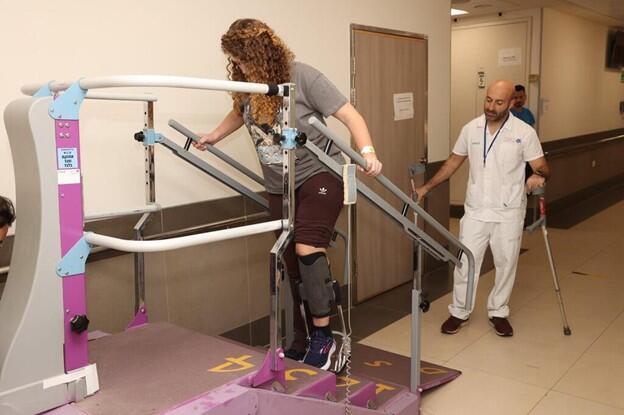

The first in the world to use the new device. Portal with the device during a physiotherapy session with Ahmad Muassi, head of physiotherapy in the Orthopedic Rehabilitation Department
(Photo: Chen Galili, Technion Spokesperson’s Office)
9 View gallery
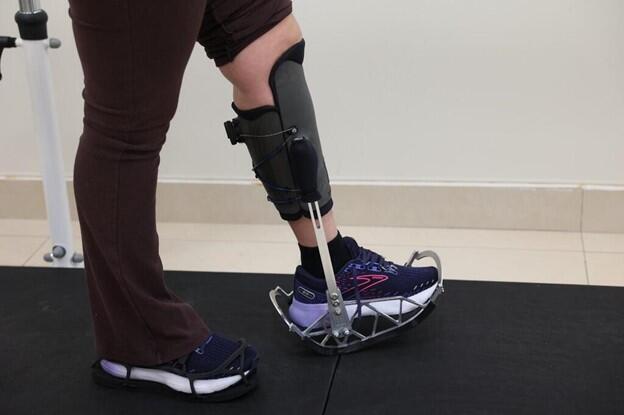

Innovative Technion device allows Portal to walk again
(Photo: Chen Galili, Technion Spokesperson’s Office)
In this case, a creative solution was needed, and it was soon found. Dr. Haim approached a long-time friend, Dr. Dana Solav, who is a member of the Technion’s Faculty of Mechanical Engineering and head of the Biomechanical Interfaces Laboratory. The two met during their doctoral studies at the Technion. As part of their professional relationship, he remembered that Solav was working on a new development that could help Portal walk again and start her rehabilitation process.
"In the entire field of rehabilitation, we have a serious problem with the interface between the soft tissue and the bone," he explains. "In the past, Dr. Solav told me that she intends to research this field. She showed me her solution and we thought about how to implement it. The idea was to create a special brace that would replace the part that interacts with the foot and imitate its movement. The concept itself is not innovative, but the design is very innovative. After October 7th, I told her about Neta’s injury and she and the Technion immediately took up the challenge and developed the device for her."
9 View gallery
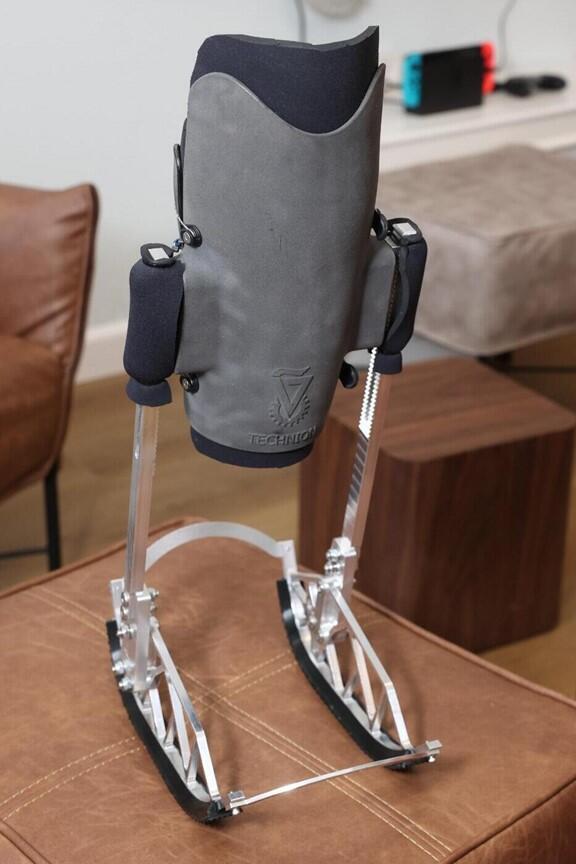

Specially made for Portal’s leg using a 3-D scan; The innovative brace
(Photo: Chen Galili, Technion Spokesperson’s Office)
"This is an invention that was developed to facilitate walking for various medical conditions in which the foot or ankle have to be offloaded, like the type of injury that Neta has. However, we were still in the development phase. We didn’t plan to implement it on patients yet," adds Dr. Solav. "When Dr. Haim called me and told me that he has a patient who exactly fits this need, the entire lab pitched in to speed up the development as much as possible and complete it. It was a collaborative effort of several team members, including undergraduate and graduate mechanical engineering students."
Dr. Solav explained that "the purpose of the brace is to enable the patient to walk as naturally and symmetrically as possible when they aren’t allowed to put full pressure on the foot or ankle, whether they are completely forbidden to step on the foot or need a partial load reduction. It bypasses the injured part of the leg and transfers all the load to the calf through a personalized brace in a similar manner as prostheses for amputated legs."
"Since it is attached to the calf, the area above the injury, particularly the knee and hip joints, can move and function normally, allowing the patient to walk in a much more natural and easy manner than by using crutches – which is something we want to avoid, since walking with crutches leads to excessive loads on the weight-bearing leg and the upper body, and does not allow the patients to exercise their natural walking patterns," he added.
As part of its development process, the device was precisely adapted to Portal’s leg. "The brace that attaches to the calf must be precisely fitted to the shape of her leg. Otherwise, the pressure won’t be distributed correctly, and it can cause pain and even pressure ulcers," says Dr. Solav.
"For amputees, this part of the device is produced using a plaster cast, and the device is designed manually in a long fabrication process. What we did was scan the foot using a three-dimensional scanner, and from there, the entire design process was done on the computer and then the brace was 3D printed and assembled with the machined metal parts," he added.
There was a great deal of excitement on the day the device arrived at the Loewenstein Center, when Neta, at long last, started walking on both feet. "It was really very emotional to see that it could do what we expected and that she was able to walk," says Dr. Solav. "She can practice walking and not let the upper leg muscles atrophy. Of course, even before that she did physiotherapy exercises for the upper leg, but at the end of the day, it’s important to practice walking."
9 View gallery
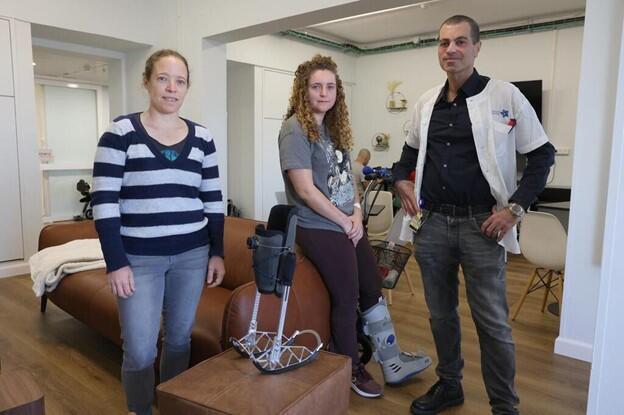

From left: Dr. Dana Solav, Neta Portal, Dr. Amir Haim
(Photo: Chen Galili, Technion Spokesperson’s Office)
A few weeks ago, Portal had an operation on her leg. "It was a type of experimental operation. They extracted fat cells in order to convert them to bone cells that will help heal the injured bone. For now, I have a cast, but I will go back to stepping on the foot in several weeks, and the device will allow me to do so in a gradual manner.
"Before the operation, thanks to the Technion’s device, I already managed to take several steps and jump on my right leg. It’s important for me to say that the work carried out by the team is amazing, and it has become an integral part of my rehab. They were very attentive and responsive. I was in a wheelchair for almost three months, and thanks to them, I went back to walking on my feet, even if not completely. They don’t know yet whether I will fully recover, but I hope so."
Dr. Haim: "Neta now has a cast, but in another one and a half weeks, as soon as we take it off and she will be allowed to step on her foot, we will go back to using the device. She is the first person in the world to use this unique aid, which was developed and built especially for her. It enables measured pressure on the ankle, which is something that is very revolutionary."
Do you expect a full recovery? "The brace won’t make her ankle heal. The long-term solution is an orthopedic solution. However, I hope that thanks to the device, she will be able to restore her walking pattern, improve functionality, prevent deterioration, and start rehabilitating her body’s movement chain. I am grateful to Dr. Solav and the Technion, which stands at the forefront of technology. The connection with academia and their developments is very important for cutting-edge medicine."




